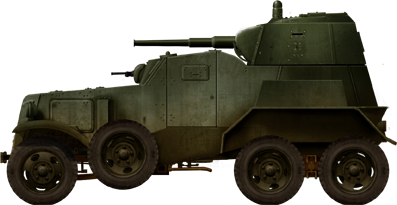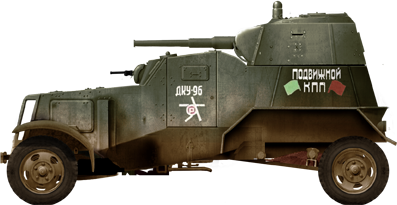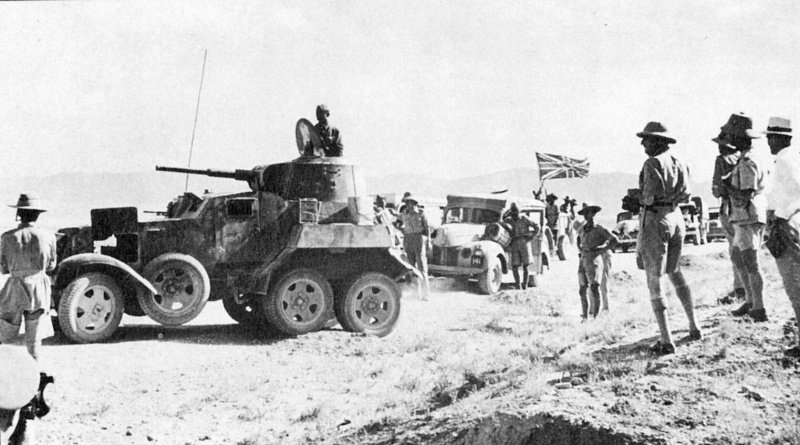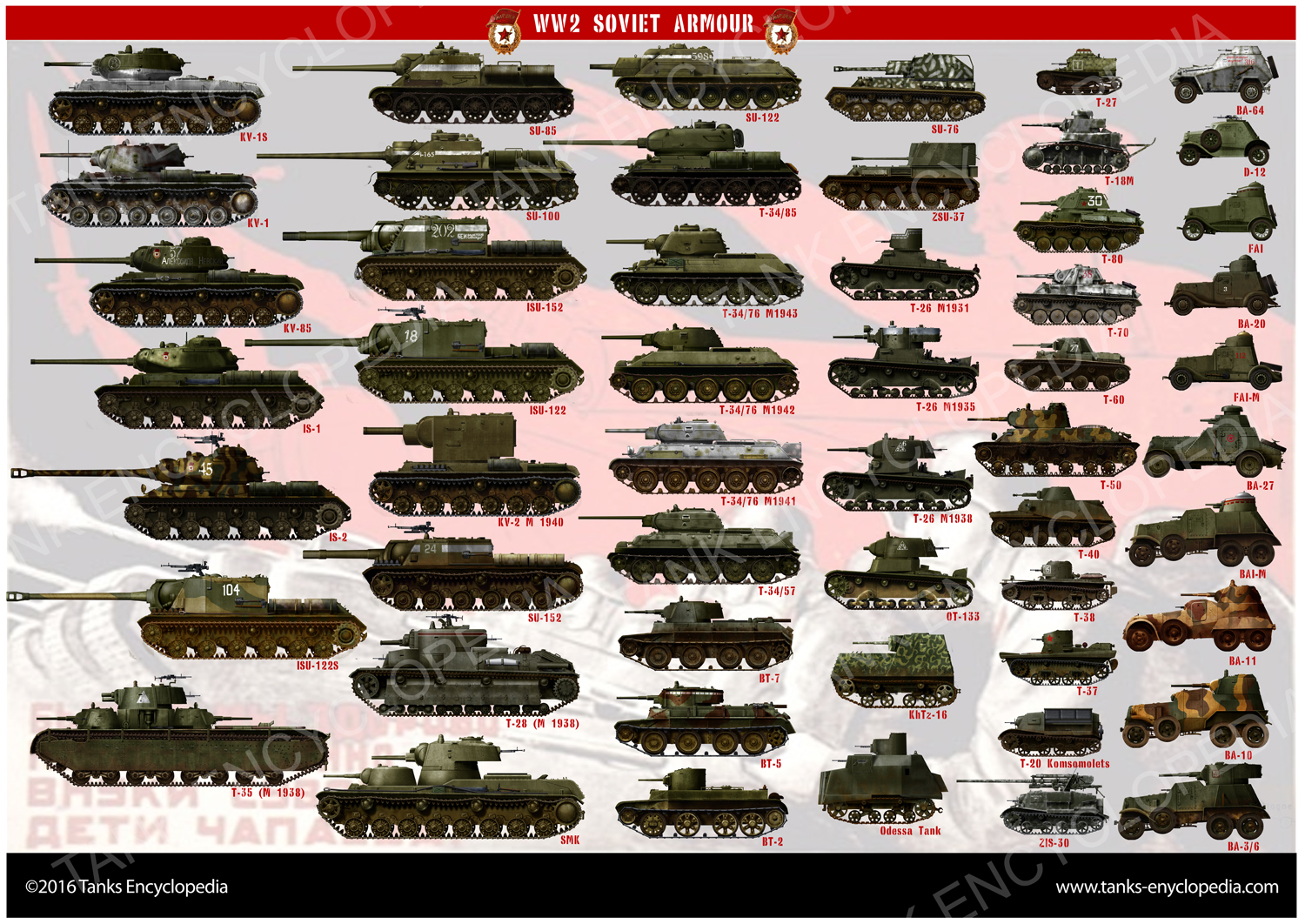The most prolific pre-war armored car
The BA-10 was the result of continued development of the BA series. A new chassis was used, and instead of out-rightly adding more armor, the designers actually reduced it, whilst at the same time sloping it, thus giving better effective protection. As a fighting vehicle, it was sophisticated and reliable compared even to international standards, not just other Soviet designs. Despite this, there were developments that would lead to it being replaced with the BA-11. However, this new vehicle was cancelled with the outbreak of war. The BA-10 was in use until 1945. A Soviet officer wields a signal pistol next to a BA-10M.
A Soviet officer wields a signal pistol next to a BA-10M.
Design process
From the late 1930s, Soviet armored fighting vehicle designers decided to use sloped armor in new designs, and redesigned some already made vehicles to take advantage of it. The BA-10 armored car was built on the GAZ-AAA six-wheeled truck chassis, which was a near copy of the Ford Timken design, albeit with an extra axle. It had been modified and reinforced to cope with the extra weight that an armored car would require. The use of a front-engined chassis placed the driver behind the engine, and there was a co-driver's machine-gun position beside him, which would be useful for frontal engagements. Power was provided by a 50 hp GAZ-M1 4-cylinder water-cooled petrol engine that gave a maximum speed of 55 km/h (34 mph), and a range of 300 km (185 mi), which was highly useful for the heavy scout role. Being a heavy armored car, the vehicle was not always best suited for off-road, but a pair of tracks for the rear wheels was given for crossing bad terrain. The BA-10 used a slightly thinner, better-sloped armor layout than that of the BA-6. This improved protection whilst saving weight, as the sloping increased the effective armor.The majority of BA-10s seen in photos are actually BA-10Ms. The original BA-10 (aka BA-6M) only saw very limited production (if any, aside from the prototype) at the Izhora Factory in April, 1937. However, it seems as though when being serially produced, a number of changes were made. There were plenty of internal wiring changes, and other unseen differences, such as the engine spark plugs being placed in a shielded box, fuel tanks were placed under the roof, ammunition capacity was reduced, and a new whip antenna was added.
 A column of BA-10Ms in winter camouflage.
A column of BA-10Ms in winter camouflage.
Variants
BA-10 (2 axles) - This was a strange variant produced by plant No. 189 in Leningrad in late October - November 1941 because of a lack of GAZ-AAA chassis. BA-10M armored hulls were installed on GAZ-AA and ZIS-5 chassis. At least six were produced. There are no photos of the vehicle based on a ZIS-5 chassis, but the GAZ-AA ones have been photographed. A rare 2 axle BA-10 used as mobile check-point at the 1st Byelorussian Front, autumn, 1944.
BA-10 ZhD - This vehicle was also very similar to the BA-10, but it also featured set of steel wheels which could be installed, allowing it to travel on road or on railway tracks. When not in use, its steel flanged rail wheels were stowed two at the rear of the vehicle and one on each stub axle located on the engine compartment sides. The BA-10 ZhD had a combat weight of 5.8 tonnes due to the weight of the steel wheels and additional ammunition load carried.
A rare 2 axle BA-10 used as mobile check-point at the 1st Byelorussian Front, autumn, 1944.
BA-10 ZhD - This vehicle was also very similar to the BA-10, but it also featured set of steel wheels which could be installed, allowing it to travel on road or on railway tracks. When not in use, its steel flanged rail wheels were stowed two at the rear of the vehicle and one on each stub axle located on the engine compartment sides. The BA-10 ZhD had a combat weight of 5.8 tonnes due to the weight of the steel wheels and additional ammunition load carried.
 A BA-10 ZhD - notice how the wheels fit onto the rail tracks.
A BA-10 ZhD - notice how the wheels fit onto the rail tracks.BA-22 - An attempt at making an ambulance / APC based on the BA-10. It seems as though this never left the prototype stage.
PB-4 - This was an amphibious variant based on the GAZ-AAA chassis, thus making it hardly a variant of the BA-10, and more of a totally different vehicle. Soviet engineers at the Izhora Factory had had issues with making amphibious armored cars, leading to at least four failed prototypes. They could not climb river banks, as the wheels got stuck in the soft mud.
In action
According to an article entitled "Soviet and German advisors: Put Doctrine to the Test: Tanks in the Siege of Madrid" by Dr. John Daley, the BA-10 was reportedly first seen in the Spanish Civil War in service with the Commune de Paris battalion against Panzergruppe Thoma, which had Panzer Is. This is false. He refers to the BA-10s having short 37 mm (1.46 in) guns, when in reality, the BA-10 had a 45 mm (1.77 in) gun. Daley is probably referring to the earlier BAI, or the AAC-1937 (Chevrolet 6x4) which was produced by Spain as a near copy of the BAI. The BA-10 was perhaps first seen at Khalkhin Gol, 1939, where roughly 80 saw active service. However, a number of them were lost, and many photographs of these knocked out vehicles exist. They saw action in all Soviet military operations 1939-1940, such as the invasion of Latvia. The BA-10 was also deployed on the Eastern Front during WWII, but was rarely seen after the winter of 1941-1942. It was usually used as a heavy scout, but it began to lose its role by 1942 to Lend Lease vehicles, as well as the T-60 and T-70. These vehicles had lost their original role to the T-34 (which was now produced in vast numbers), and could therefore be relegated to minor roles such as heavy scout. Some BA-10s were, however, seen in Leningrad as late as 1943. Despite its weight, the BA-10 was a reasonably reliable vehicle and, despite the limitations of its 6x4 drive, served the Red Army well until the German invasion of 1941. After 1941, few Soviet armored cars survived the early battles with the German Wehrmacht. Those that remained in Soviet hands were withdrawn from front line service after 1942, although many would be stripped down to be used as armored personnel carriers. A BA-10M knocked out at Khalkhin Gol.
A BA-10M knocked out at Khalkhin Gol.
The BA-10 in foreign service
Finland – The Finnish army captured BA-10Ms during the Winter War and Continuation War, and they were designated the BAF C. Detailed information on inventory before June 1944 is scarce, but it appears that roughly 13 were captured and saw service in the Continuation War. In 1941, they were issued to separate platoons, but were later given to the Finnish Armored Division (Ps.D), and they were used as command, supply and signal vehicles. The Finns actually considered the engine and maneuverability too poor, and replaced the engines with Ford V8 95hp engines. One BAF C was lost in summer, 1944. After WWII, the remaining twelve BAF Cs were used as recon vehicles by different battalions. By 1958, only four remained in service, and were finally taken out of service in 1959. One is on display at the Finnish Armour Museum in Parola. One BAF C was modified as a crane vehicle in 1961 by removing its turret and most of armored hull, it remained in use with the Finnish Army until 1978.
A BAF C (left) next to a BAF A (right). The BAF A is the Finnish designation for captured BA-3s. Sweden – In 1942, Sweden requested Finland to send them some captured Soviet heavy armored cars for testing. The Finns sold to the Swedish three damaged BAF Cs and delivered them in October, 1942. They were without engines, tires, and transmission boxes at the cost of 5000 Kronas. They were repaired, and were given Swedish weapons, such as a Kulspruta M/39 machine gun next to the driver, but it did not feature a main gun in the turret. They also had improved radios, with a new antenna atop the turret. These were designated Pansarbil M/13F, and remained in service until the 1950s as command vehicles. One remains at the Swedish Tank Museum in Skövde.
Germany - Large numbers of these vehicles were captured, and the Germans used them for anti-partisan duties both in the USSR and in the Balkans; a role in which these vehicles excelled. The German-allied ROA was reported to have used some against the Red Army during the liberation of Prague.
Nationalist China - After the heavy losses in 1937 at the Battle of Shanghai and the Battle of Nanjing, the KMT appealed to the USSR for arms sales. As a result of the Sino-Soviet Non-Aggression Pact, signed in August, 1937, the USSR began supplying the KMT's newly formed 200th Division with Soviet equipment. 83 T-26s were sold, along with small, but unknown numbers of BT-5s (at least 4), BA-27s (at least 4), BA-3/6s (unclear which model, at least two), BA-20s (unclear which model), and possibly some BA-10Ms (which are possibly misidentified BA-3/6s).
Manchukuo - The Imperial Japanese Army captured many Soviet weapons at the Battle of Khalkin Gol. Among them was at least one BA-10M, which was transferred to the Manchukuo Imperial Army, as proven by a photo showing one with a military star version of the ‘Five Races Under One Union’ flag.
 BA-10M of Manchukuo Imperial Army, February, 1940. On the crew door is a military star version of the ‘Five Races Under One Union’ flag. This vehicle was captured by the IJA at Khalkin Gol.
BA-10M of Manchukuo Imperial Army, February, 1940. On the crew door is a military star version of the ‘Five Races Under One Union’ flag. This vehicle was captured by the IJA at Khalkin Gol.
BA-10M specification |
|
| Dimensions (L-w-h) | 4.65 x 2 x 2.2 m (15.3 x 6.56 x 7.2ft) |
| Total weight, battle ready | 5.1 tonnes |
| Crew | 4 |
| Propulsion | GAZ-M1 4-cylinder water-cooled petrol engine, 50hp |
| Speed (road) | 55 km/h (34 mph) |
| Range | 300 km (185 miles) |
| Armament | 45 mm (1.77 in) 20-K 2 x DT 7.62 mm (0.3 in) machine-guns |
| Armor | 6-15 mm (0.23 - 0.59 in) |
| Total production | 3,311 |

BA-6M, testing the newly developed sloped turret in 1937. Only a handful entered service before the production was shifted on the BA-10.

BA-10M in regular olive green livery upon entering service in 1939.

BA-10M, winter camouflage and tracks (Finland, 1939)

BA-10M, winter camouflage with green vermicels, Finland 1939-40

Camouflaged BA-10M, Leningrad Front, summer 1942

BA-10M with tracks on the rear axle, winter 1942

BA-10 with two axles used as mobile check-point, 1st Bielorussian front, October 1944.

Panzerspähwagen BA 203(r), 402 Bicycle Batallion, winter 1941-42

BA-10A, Leningrad Front, winter 1943

BA-10ZhD, the rail conversion variant.

BA-10M of Vlasov's Russian Legion, 1942.

BA-10M, reportedly in service with the Chinese Nationalist 200th Division, in 1938. Speculative colors only, as this is likely a mis-identification of a BA-3/6.

BA-10M of the Manchukuo Imperial Army, circa February, 1940. This vehicle was originally captured at the Battle of Khalkin Gol by the Imperial Japanese Army.
Gallery

Some BA-10Ms in Romania. A few T-26 M1931s, and seemingly an OT-26 can be seen behind them.

A BA-10M with a British column in Iran.

A Pansarbil M/13F in Stockholm, Sweden.

A German captured BA-10M.

A knocked-out BA-10A (from the first lot of 60 vehicles) next to a T-38 light amphibious tank somewhere in a Soviet city. Source: Bronson, British Collectors of Arms & Militaria Forum.
Sources and further reading
“Soviet Tanks and Combat Vehicles of WWII” by Steven Zaloga and James Grandsen “Отечественные бронеавтомобили 1905-1941” by A. G. Solyankin Armchairgeneral.comStatusreport blog
Jaegerplatoon.net

ww2 Soviet Tanks Poster

WW2 Tanks




























WW2 tanks posters

All Tiger tanks liveries.

Panther liveries and variants

WW2 Armour - All tanks











Tanks aces and single tanks series

Find more there

Museums, Movies, Books & Games
The Tanks and Armor in pop culture
Tanks and armored vehicles in general are only really grasped when seen first person: The mass, the scale, it's all there. Explore also the way tanks were covered in the movie industry, in books and in video games.Movies:
Best tanks movie on warhistoryonline.com
On imdb.com
On bestsimilar.com/
miltours.com
liveabout.com/
watchmojo.com
Video Games:
pcgamesn.com
historyhit.com
levvvel.com
vg247.com/best-tank-games
mmobomb.com/
alienwarearena.com

